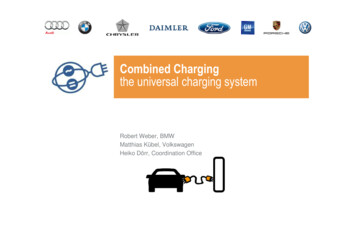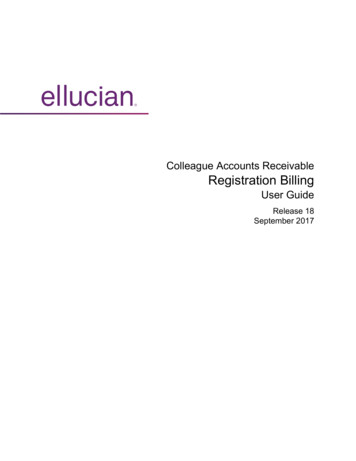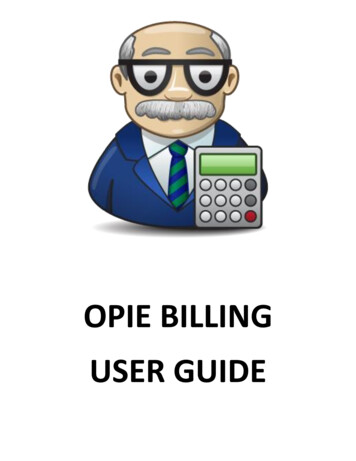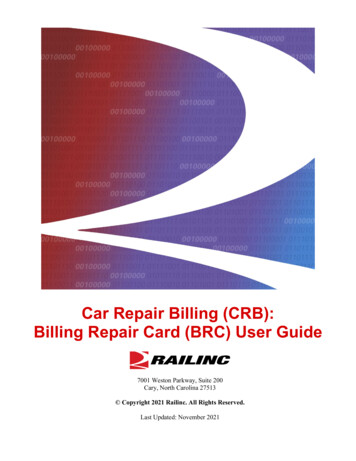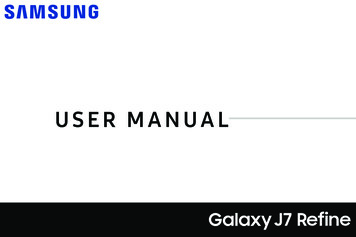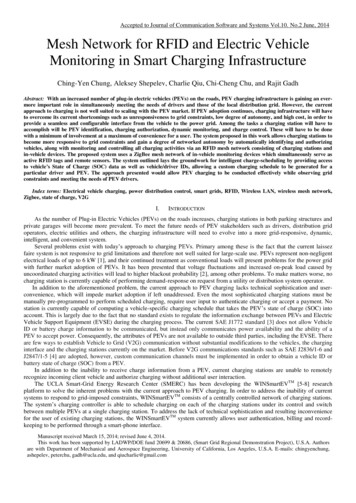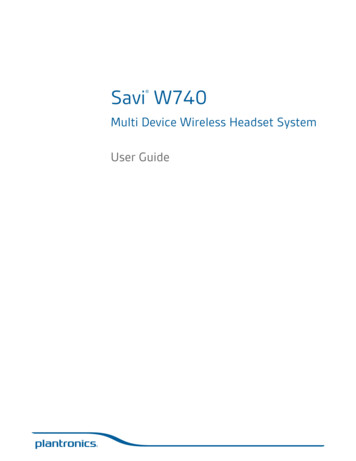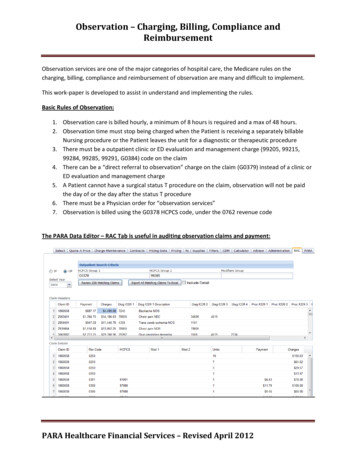
Transcription
Observation – Charging, Billing, Compliance andReimbursementObservation services are one of the major categories of hospital care, the Medicare rules on thecharging, billing, compliance and reimbursement of observation are many and difficult to implement.This work‐paper is developed to assist in understand and implementing the rules.Basic Rules of Observation:1. Observation care is billed hourly, a minimum of 8 hours is required and a max of 48 hours.2. Observation time must stop being charged when the Patient is receiving a separately billableNursing procedure or the Patient leaves the unit for a diagnostic or therapeutic procedure3. There must be a outpatient clinic or ED evaluation and management charge (99205, 99215,99284, 99285, 99291, G0384) code on the claim4. There can be a “direct referral to observation” charge on the claim (G0379) instead of a clinic orED evaluation and management charge5. A Patient cannot have a surgical status T procedure on the claim, observation will not be paidthe day of or the day after the status T procedure6. There must be a Physician order for “observation services”7. Observation is billed using the G0378 HCPCS code, under the 0762 revenue codeThe PARA Data Editor – RAC Tab is useful in auditing observation claims and payment:PARA Healthcare Financial Services – Revised April 2012
Observation – Charging, Billing, Compliance andReimbursementReimbursement Considerations1. Medicare Reimbursement will be packaged into the APC: Most commonly, observationservices are provided after an emergency department evaluation (99284/99285). Whenobservation (G0378) is billed with an E/M code from the Emergency Department, Medicare willpay the higher APC (provided no status T HCPCS procedure was provided on the same day orthe day prior to observation services.) Since G0378 is considered packaged into the APC, thehigher payment appears on the remit next to the E/M code line item, not the G0378 line.2. Change from Observation to Inpatient Status: Whenever possible, Utilization Review staffshould evaluate every patient in observation status prior to discharge to determine whetherthe patient meets the hospital criteria for inpatient status assignment. If the patient meetscriteria, the Utilization Review staff should confer with the physician to consider changing thepatient to inpatient status. Any change in status must be accomplished prior to discharge andsupported by an appropriate physician order. Inpatient payment under Medicare IPPS DRG’s istypically much higher than the alternative APC reimbursement as an outpatient claim (threeexamples at the end of this document illustrate inpatient DRG to outpatient/APCreimbursement.)3. Change from Inpatient to Observation Status: Prior to discharge, the attending physician orthe hospital’s UR Committee may document an order to change the status of an admittedinpatient to observation status if the case does not meet inpatient status criteria (intensity ofservice/severity of illness.) In that event, the claim for observation services must indicateCondition Code 44. For more information, refer to CMS Publication 100‐04, Transmittal 299,“Use of Condition Code 44” athttp://www.saem.org/sites/default/files/Handouts R299CP‐code44.pdf4. Monitor PEPPER Reports: Hospitals should download and review data from Medicare’sProgram for Evaluating Payment Patterns Electronic Report (“PEPPER”) to determine if thefacility is within the normal range for short stays within DRG’s. Those that have a higher rate ofshort‐stays than normal within a given DRG are more likely to be audited for medical necessityby RAC auditors. Those hospitals which may be unusually low in short stays may find thereport reveals overuse of observation status and an opportunity to improve revenue byreviewing cases which may meet inpatient criteria to assign the correct patient status prior pxPARA Healthcare Financial Services – Revised April 2012
Observation – Charging, Billing, Compliance andReimbursement290.1 - Observation Services Overview(Rev. 1760, Issued: 06-23-09; Effective Date: 07-01-09; Implementation Date: 0706-09)Observation care is a well-defined set of specific, clinically appropriate services, whichinclude ongoing short term treatment, assessment, and reassessment, that are furnishedwhile a decision is being made regarding whether patients will require further treatmentas hospital inpatients or if they are able to be discharged from the hospital. Observationservices are commonly ordered for patients who present to the emergency department andwho then require a significant period of treatment or monitoring in order to make adecision concerning their admission or discharge.Observation services are covered only when provided by the order of a physicianor another individual authorized by State licensure law and hospital staff bylawsto admit patients to the hospital or to order outpatient services.Observation services must also be reasonable and necessary to be covered by Medicare.In only rare and exceptional cases do reasonable and necessary outpatient observationservices span more than 48 hours. In the majority of cases, the decision whether todischarge a patient from the hospital following resolution of the reason for theobservation care or to admit the patient as an inpatient can be made in less than 48 hours,usually in less than 24 hours.290.2.1 - Revenue Code Reporting(Rev. 1760, Issued: 06-23-09; Effective Date: 07-01-09; Implementation Date: 0706-09)Hospitals are required to report observation charges under the following revenue codes:Revenue CodeSubcategory07600762General Classification categoryObservation RoomOther ancillary services performed while the patient receives observation services arereported using appropriate revenue codes and HCPCS codes as applicable.PARA Healthcare Financial Services – Revised April 2012
Observation – Charging, Billing, Compliance andReimbursement290.2.2 - Reporting Hours of Observation(Rev. 1760, Issued: 06-23-09; Effective Date: 07-01-09; Implementation Date: 0706-09)Observation time begins at the clock time documented in the patient’s medical record,which coincides with the time that observation care is initiated in accordance with aphysician’s order. Hospitals should round to the nearest hour. For example, a patientwho began receiving observation services at 3:03 p.m. according to the nurses’ notes andwas discharged to home at 9:45 p.m. when observation care and other outpatient serviceswere completed, should have a “7” placed in the units field of the reported observationHCPCS code.General standing orders for observation services following all outpatient surgery are notrecognized. Hospitals should not report as observation care, services that are part ofanother Part B service, such as postoperative monitoring during a standard recoveryperiod (e.g., 4-6 hours), which should be billed as recovery room services. Similarly, inthe case of patients who undergo diagnostic testing in a hospital outpatient department,routine preparation services furnished prior to the testing and recovery afterwards areincluded in the payments for those diagnostic services. Observation services should notbe billed concurrently with diagnostic or therapeutic services for which active monitoringis a part of the procedure (e.g., colonoscopy, chemotherapy). In situations where such aprocedure interrupts observation services, hospitals would record for each period ofobservation services the beginning and ending times during the hospital outpatientencounter and add the length of time for the periods of observation services together toreach the total number of units reported on the claim for the hourly observation servicesHCPCS code G0378 (Hospital observation service, per hour). Observation time endswhen all medically necessary services related to observation care are completed. Forexample, this could be before discharge when the need for observation has ended, butother medically necessary services not meeting the definition of observation care areprovided (in which case, the additional medically necessary services would be billedseparately or included as part of the emergency department or clinic visit). Alternatively,the end time of observation services may coincide with the time the patient is actuallydischarged from the hospital or admitted as an inpatient. Observation time may includemedically necessary services and follow-up care provided after the time that thephysician writes the discharge order, but before the patient is discharged. However,reported observation time would not include the time patients remain in the hospital aftertreatment is finished for reasons such as waiting for transportation home.If a period of observation spans more than 1 calendar day, all of the hours for the entireperiod of observation must be included on a single line and the date of service for thatline is the date that observation care begins.PARA Healthcare Financial Services – Revised April 2012
Observation – Charging, Billing, Compliance andReimbursement290.5.1 - Billing and Payment for Observation Services BeginningJanuary 1, 2008(Rev. 1760, Issued: 06-23-09; Effective Date: 07-01-09; Implementation Date: 0706-09)Observation services are reported using HCPCS code G0378 (Hospital observationservice, per hour).Beginning January 1, 2008, HCPCS code G0378 for hourly observation servicesis assigned status indicator N, signifying that its payment is always packaged.No separate payment is made for observation services reported with HCPCScode G0378, and APC 0339 is deleted as of January 1, 2008.In most circumstances, observation services are supportive and ancillary to the other servicesprovided to a patient. In certain circumstances when observation care is billed in conjunctionwith a high level clinic visit (Level 5), high level Type A emergency department visit (Level 4or 5), high level Type B emergency department visit (Level 5), critical care services, or adirect referral as an integral part of a patient’s extended encounter of care, payment maybe made for the entire extended care encounter through one of two composite APCs whencertain criteria are met. For information about payment for extended assessment andmanagement composite APCs, see §10.2.1 (Composite APCs) of this chapter.APC 8002 (Level I Extended Assessment and Management Composite) describes anencounter for care provided to a patient that includes a high level (Level 5) clinic visit ordirect referral for observation in conjunction with observation services of substantialduration (8 or more hours). APC 8003 (Level II Extended Assessment and ManagementComposite) describes an encounter for care provided to a patient that includes a highlevel (Level 4 or 5) emergency department visit or critical care services in conjunctionwith observation services of substantial duration. Beginning January 1, 2009, APC 8003also includes high level (Level 5) Type B emergency department visits. There is nolimitation on diagnosis for payment of these composite APCs; however, composite APCpayment will not be made when observation services are reported in association with asurgical procedure (T status procedure) or the hours of observation care reported are lessthan 8. The I/OCE evaluates every claim received to determine if payment through acomposite APC is appropriate.If payment through a composite APC is inappropriate, the I/OCE, in conjunctionwith the Pricer, determines the appropriate status indicator, APC, and payment forevery code on a claim.PARA Healthcare Financial Services – Revised April 2012
Observation – Charging, Billing, Compliance andReimbursement290.5.1 - Billing and Payment for Observation Services BeginningJanuary 1, 2008(Rev. 1760, Issued: 06-23-09; Effective Date: 07-01-09; Implementation Date: 0706-09)All of the following requirements must be met in order for a hospital to receive an APCpayment for an extended assessment and management composite APC:1. Observation Timea. Observation time must be documented in the medical record.b. Hospital billing for observation services begins at the clock time documented inthe patient’s medical record, which coincides with the time that observationservices are initiated in accordance with a physician’s order for observationservices.c. A beneficiary's time receiving observation services (and hospital billing) endswhen all clinical or medical interventions have been completed, including follow-upcare furnished by hospital staff and physicians that may take place after aphysician has ordered the patient be released or admitted as an inpatient.d. The number of units reported with HCPCS code G0378 must equal or exceed 8hours.2. Additional Hospital Servicesa. The claim for observation services must include one of the following services inaddition to the reported observation services. The additional services listed belowmust have a line item date of service on the same day or the day before the datereported for observation:A Type A or B emergency department visit (CPT codes 99284 or 99285 orHCPCS code G0384); orA clinic visit (CPT code 99205 or 99215); orCritical care (CPT code 99291); orDirect referral for observation care reported with HCPCS code G0379 (APC0604) must be reported on the same date of service as the date reported forobservation services.b. No procedure with a T status indicator can be reported on the same day or daybefore observation care is provided.PARA Healthcare Financial Services – Revised April 2012
Observation – Charging, Billing, Compliance andReimbursement290.5.1 - Billing and Payment for Observation Services BeginningJanuary 1, 2008(Rev. 1760, Issued: 06-23-09; Effective Date: 07-01-09; Implementation Date: 0706-09)3. Physician Evaluationa. The beneficiary must be in the care of a physician during the period ofobservation, as documented in the medical record by outpatient registration,discharge, and other appropriate progress notes that are timed, written, and signedby the physician.b. The medical record must include documentation that the physician explicitlyassessed patient risk to determine that the beneficiary would benefit fromobservation care.Criteria 1 and 3 related to observation care beginning and ending time and physicianevaluation apply regardless of whether the hospital believes that the criteria will be metfor payment of the extended encounter through extended assessment and managementcomposite payment.Only visits, critical care and observation services that are billed on a 13X bill type maybe considered for a composite APC payment.Non-repetitive services provided on the same day as either direct referral for observationcare or observation services must be reported on the same claim because the OCE claim byclaim logic cannot function properly unless all services related to the episode ofobservation care, including hospital clinic visits, emergency department visits, criticalcare services, and T status procedures, are reported on the same claim. Additionalguidance can be found in chapter 1, section 50.2.2 of this manual.If a claim for services provided during an extended assessment and managementencounter including observation care does not meet all of the requirements listed above,then the usual APC logic will apply to separately payable items and services on theclaim; the special logic for direct admission will apply, and payment for the observationcare will be packaged into payments for other separately payable services provided to thebeneficiary in the same encounter.PARA Healthcare Financial Services – Revised April 2012
Observation – Charging, Billing, Compliance andReimbursement290.5.2 - Billing and Payment for Direct Referral for Observation CareFurnished Beginning January 1, 2008(Rev. 1882, Issued: 12-21-09; Effective Date: 01-01-10; Implementation Date: 0104-10)Direct referral for observation is reported using HCPCS code G0379 (Direct referral forhospital observation care). Note: Prior to January 1, 2010, the code descriptor forHCPCS code G0379 was (Direct admission of patient for hospital observation care).Hospitals should report G0379 when observation services are the result of a directreferral for observation care without an associated emergency room visit, hospitaloutpatient clinic visit, or critical care service on the day of initiation of observationservices. Hospitals should only report HCPCS code G0379 when a patient is referreddirectly to observation care after being seen by a physician in the community.Payment for direct referral for observation care will be made either separately as a lowlevel hospital clinic visit under APC 0604 or packaged into payment for composite APC8002 (Level I Prolonged Assessment and Management Composite) or packaged into thepayment for other separately payable services provided in the same encounter. Forinformation about payment for extended assessment and management composite APCs,see, §10.2.1 (Composite APCs) of this chapter.The criteria for payment of HCPCS code G0379 under either APC 0604 or APC 8002include:1. Both HCPCS codes G0378 (Hospital observation services, per hr.) and G0379(Direct referral for hospital observation care) are reported with the same date ofservice.2. No service with a status indicator of T or V or Critical Care (APC 0617) isprovided on the same day of service as HCPCS code G0379.If either of the above criteria is not met, HCPCS code G0379 will be assigned statusindicator N and will be packaged into payment for other separately payable servicesprovided in the same encounter.Only a direct referral for observation services billed on a 13X bill type may be consideredfor a composite APC payment.PARA Healthcare Financial Services – Revised April 2012
Observation – Charging, Billing, Compliance andReimbursement290.6 - Services Not Covered as Observation Services(Rev. 1445, Issued: 02-08-08; Effective: 01-01-08; Implementation: 03-10-08)Hospitals must not bill beneficiaries directly for reasonable and necessary observationservices for which the OPPS packages payment for observation as part of the payment forthe separately payable items and services on the claim. Hospitals should not confusepackaged payment with non-coverage or nonpayment. See the Medicare Benefit PolicyManual, Pub 100-02, chapter 6, section 20.6 for further explanation of non-coveredservices and notification of the beneficiary in relation to observation care.PARA Healthcare Financial Services – Revised April 2012
Observation – Charging, Billing, Compliance andReimbursementPARA Healthcare Financial Services – Revised April 2012
Observation – Charging, Billing, Compliance andReimbursementPARA Healthcare Financial Services – Revised April 2012
Observation – Charging, Billing, Compliance andReimbursementPARA Healthcare Financial Services – Revised April 2012
should evaluate every patient in observation status prior to discharge to determine whether the patient meets the hospital criteria for inpatient status assignment. . code G0378, and APC 0339 is deleted as of January 1, 2008. In most circumstances, observation services are supportive and ancillary to the other services provided to a patient .
